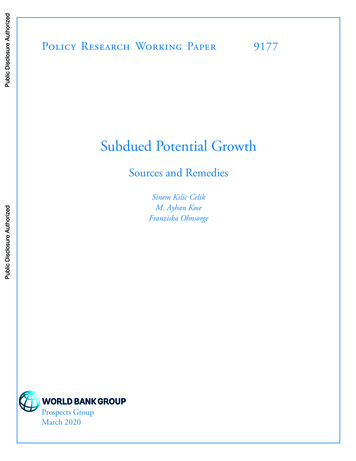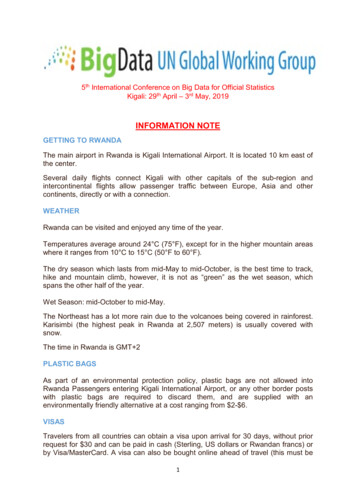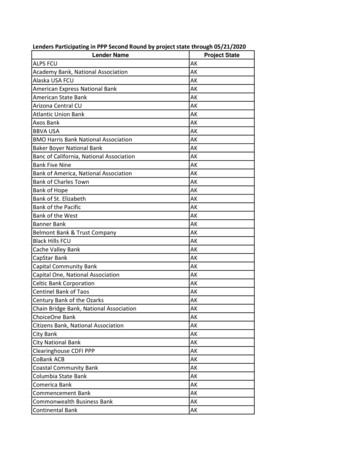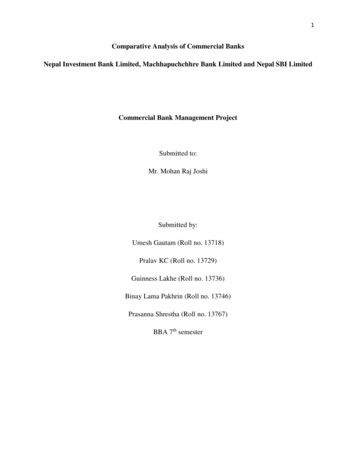
Transcription
Public Disclosure AuthorizedPublic Disclosure AuthorizedPolicy Research Working Paper9177Subdued Potential GrowthSources and RemediesPublic Disclosure AuthorizedPublic Disclosure AuthorizedSinem Kilic CelikM. Ayhan KoseFranziska OhnsorgeProspects GroupMarch 2020
Policy Research Working Paper 9177AbstractGlobal potential output growth has been flagging. At 2.5percent in 2013–17, post-crisis potential growth is 0.5percentage point below its longer-term average and 0.9percentage point below its average a decade ago. Comparedwith a decade ago, potential growth has declined 0.8 percentage point in advanced economies and 1.1 percentagepoint in emerging market and developing economies. Theslowdown mainly reflected weaker capital accumulationbut is also evidence of decelerating productivity growthand demographic trends that dampen labor supply growth.Unless countered, these forces are expected to continue andto depress global potential growth further by 0.2 percentagepoint over the next decade. A menu of policy options isavailable to help reverse this trend, including comprehensive policy initiatives to lift physical and human capitaland to encourage labor force participation by women andolder workers.This paper is a product of the Prospects Group. It is part of a larger effort by the World Bank to provide open access to itsresearch and make a contribution to development policy discussions around the world. Policy Research Working Papers arealso posted on the Web at http://www.worldbank.org/prwp. The authors may be contacted at skiliccelik@worldbank.org,akose@worldbank.org, and fohnsorge@worldbank.org.The Policy Research Working Paper Series disseminates the findings of work in progress to encourage the exchange of ideas about developmentissues. An objective of the series is to get the findings out quickly, even if the presentations are less than fully polished. The papers carry thenames of the authors and should be cited accordingly. The findings, interpretations, and conclusions expressed in this paper are entirely thoseof the authors. They do not necessarily represent the views of the International Bank for Reconstruction and Development/World Bank andits affiliated organizations, or those of the Executive Directors of the World Bank or the governments they represent.Produced by the Research Support Team
Subdued Potential Growth:Sources and RemediesSinem Kilic Celik, M. Ayhan Kose, and Franziska Ohnsorge *JEL Classification: O40, O47, E20Keywords: Potential growth, potential output, advanced economies, emerging market anddeveloping economies*Kilic Celik (Prospects Group, World Bank; skiliccelik@worldbank.org), Kose (Prospects Group, World Bank;Brookings Institution; CEPR; CAMA; akose@worldbank.org); Ohnsorge (Prospects Group, World Bank; CEPR;CAMA; fohnsorge@worldbank.org. We thank Martin Bailey and Zia Qureshi for their detailed comments. Weappreciate feedback from Eduardo Borenzstein, Kevin Clinton, Brahima Coulibaly, Antonio Fatas, Thomas Helbling,Homi Kharas, Ugo Panizza, and Jonathan Temple. Xinghao Gong provided excellent research assistance. Thefindings, interpretations and conclusions expressed in this paper will be entirely those of the authors and should notbe attributed to the World Bank, its Executive Directors, or the countries they represent.
1. IntroductionThe global economy regained some strength over the period between mid-2016 and 2018but potential output growth—the rate at which an economy would grow when labor andcapital are fully employed—has continued to remain weak (Figure 1). Post-crisis (201317), global potential growth fell short of its long-term average and was well below its precrisis average. This weakness was broad-based, affecting both advanced economies, whereit was evident even before the financial crisis, and emerging market and developingeconomies (EMDEs), where there was a short-lived pre-crisis uptick.Since the growth rate of per capita potential output is the overriding long-run force forsustained reductions in poverty, this trend is also cause for concern about the internationalcommunity’s ability to meet broader development goals. 1 In some regions, especiallycommodity-exporting ones, such as Eastern Europe and Central Asia, and the MiddleEast and North Africa, the post-crisis slowdown in potential growth could set back percapita income convergence by more than a decade.Against this backdrop, this paper addresses the following questions. First, how haspotential growth evolved since the turn of the century? Second, what have been the driversof potential growth? Third, what are the prospects for potential growth? Fourth, whatpolicy options are available to lift potential growth?To help answer these questions, the paper examines the evolution of potential growth ina large sample of countries, with a strong regional focus. Since potential output is notdirectly observable, economists estimate it from long time series of actual output,employment, capital stocks, and productivity. The paper uses a comprehensive databaseof potential output growth by Kilic Celik et al. (forthcoming). 2 For clarity, and in keepingwith a longer-term focus, this study uses the production function approach. 3This paper makes several contributions to the large literature on potential growth. First,the focus in this study is on the broader EMDE universe, whereas other studies havedocumented a potential growth slowdown in advanced economies and Asian economies.(IMF 2015; Dabla-Norris et al. 2015; Asian Development Bank 2016; and OECD 2014).Second, the paper examines global trends in the structural drivers of potential growth,including total factor productivity (TFP) growth, labor supply growth, and investmentin human and physical capital. Third, it explores policy options to lift potential growth.These include measures to improve education and reforms to health care and labor1Research suggests that two-thirds of cross-country differences in growth of the poorest households’ income areaccounted for by differences in average income growth (Dollar, Kraay, and Kleineberg 2013; Barro 2000).Mechanisms by which overall growth helps reduce inequality differ but include its impact in raising the demand foragricultural output which helps poor land holders, as well as rising urbanization and higher wages (Yankow 2006;Gould 2007; Ravallion and Datt 2002).2Most of the existing literature on potential growth involves estimating the role of output gaps in driving inflation ordomestic monetary policy in the context of individual countries (in about half of 67 publications for individual EMDEssurveyed by the authors).3Other measures of potential growth incorporate short-term supply shocks that dissipate over time (Kilic Celik et al.forthcoming).2
markets. In contrast to earlier studies, the discussion of policy options to lift potentialgrowth is directly derived from the empirical exercise. 4The paper’s principal conclusions are as follows. First, the global financial crisis hasushered in a period of persistently weak potential growth. During 2013-17, global potentialgrowth (2.5 percent a year) fell 0.5 percentage point below its longer-term (1998-2017)average, and even further below its average a decade ago (2003-07). Potential outputdecelerated in advanced economies to 1.4 percent a year during 2013-17, which is 0.5percentage point below its long-term average. Similarly, EMDE potential growth slowedto 4.8 percent a year, 0.6 percentage point below its longer-term average. This weaknessin potential growth has been broad-based, affecting almost half of EMDEs and 87 percentof advanced economies in the sample, together representing 69 percent of global GDP.Second, a host of factors have contributed to this post-crisis shortfall in potential growthbelow longer-term averages. Half of the deceleration reflects weaker-than-average rates ofcapital accumulation. Just over one-quarter of the slowdown is due to weaker total factorproductivity (TFP) growth while just under one-quarter of the moderation is attributableto demographic trends.Third, the slowdown in potential growth may extend into the next decade. Trends in itsfundamental drivers suggest that global potential growth may slow further by 0.2percentage point on average over 2018-27. While the decline in potential growth isexpected be 0.1 percentage point a year in advanced economies, EMDE potential growthcould ease much more, by 0.5 percentage point. The projected slowdown from 2013-17would affect EMDEs and advanced economies that account for 73 percent of global GDP.Fourth, policies could help reverse these trends and boost global growth. For advancedeconomies, labor market reforms (especially targeting pension systems) may have thehighest potential to stem the decline in potential growth. Among EMDEs, in particular,education, health, and labor market reforms could significantly increase potential growth.A combination of these policies could lift potential growth in EMDEs over the next decadeby 0.8percentage point, and more in EAP and ECA.To sustain higher potential growth, countries need to reform labor and product markets,strengthen human and physical capital and build conducive environments for businessand households to invest. The onus is particularly on the largest emerging markets andadvanced economies, whose growth momentum generates spillovers for other EMDEs.This paper draws on a comprehensive database that estimates potential growth using allstandard approaches for up to 181 countries for 1980-2017 (extending to 2027 for 80countries) based on Kilic Celik et al. (forthcoming). For clarity, the remainder of thepaper presents only results using a production function approach for 30 advancedeconomies and 50 emerging market and developing economies for 1998-2027 that together4Other studies have investigated the link between actual growth or productivity growth and structural reforms,focusing on the near-term benefits (Prati, Onorato, and Papageorgiou 2013), productivity effects (Dabla-Norris, Ho,and Kyobe 2015; Adler et al. 2017) or a sample consisting of mostly advanced economies (Banerji et al. 2017; IMF2015 and 2016b).3
account for 91 percent of global GDP. 52. Evolution of Potential Growth: What Happened?2.1. Slowdown in global potential growthGlobal potential growth fell to 2.5 percent a year during 2013-17. This is below its longerterm (1998-2017) average of 3 percent a year and even further below its average a decadeearlier (2003-07; Figure 2). The potential growth weakness was broad-based and robustto the specific choice of potential growth measures. During 2013-17, potential growth wasbelow its longer-term average in 87 percent of advanced economies and in almost half ofEMDEs. Economies with potential growth below its longer-term average accounted forroughly 70 percent of global GDP.Per capita estimates also show a trend deceleration. These estimates suggest that therewas a persistent slowdown in global potential growth beneath the temporary cyclicalshocks that appear to have been the main reasons for the post-crisis slowdown in actualgrowth from elevated pre-crisis levels. In advanced economies, the potential growthslowdown set in before the global financial crisis whereas EMDEs enjoyed a short-livedpre-crisis surge in potential growth that subsequently faded.Among advanced economies, following a sharp decline during 2008-12—the period of theglobal financial crisis, the Euro Area crisis, and pronounced investment weakness—potential growth stabilized in 2013-17 as investment growth recovered. 6 However, at 1.4percent a year over 2013-17, potential growth in advanced economies remains about 0.5percent-age points below its longer-term average. The decline was particularly pronouncedin some countries in Asia.In EMDEs, in the initial wake of the global financial crisis, a surge in public investmentunderpinned EMDE potential growth, offsetting softening productivity and labor supplygrowth. As EMDE policy stimulus was unwound, and as investment growth plummetedin commodity-exporting EMDEs following the oil price slide in mid-2014, EMDE potentialgrowth slowed sharply to 4.8 percent a year in 2013-17, 0.6 percentage point below itslonger-term average. 75The 50 EMDEs include 4 economies in East Asia and the Pacific, 9 economies in Europe and Central Asia, 15economies in Latin America and the Caribbean, 7 economies in the Middle East and North Africa, 2 economies inSouth Asia and 13 economies in Sub-Saharan Africa (Kilic Celik et al. forthcoming). Please see Table 1 for the list ofcountries in each group and region. Data for more than one-third of them (and about half of the sample’s EMDEs inEurope and Central Asia and Sub-Saharan Africa) is missing before 1997 and no data for EMDEs is available before1991. Hence, to ensure broad country coverage, the sample period is restricted to 1998-2027.6As in the broader set of advanced economies, potential growth in G7 economies—Canada, France, Germany, Italy,Japan, United Kingdom, and United States—was, at 1.5 percent on average in 2013-17, 0.3 percentage points belowits longer-term average.7The potential growth slowdown from pre-crisis rates was also evident in EM7 economies—Brazil, China, India,Indonesia, Mexico, Russia, and Turkey. On average during 2013-17, EM7 potential growth slowed to 5.4 percent.Almost three-quarters of this decline in EM7 potential growth between 2003-07 and 2013-17 reflected slowingpotential growth in China.4
2.2. Regional heterogeneityPotential growth has fallen furthest in EMDE regions that had benefited from rapid percapita income convergence or that hosted many commodity-exporting EMDEs (Figure 3).The shortfall of potential growth during 2013-17 from its longer-term (1998-2017) averagewas one of the sharpest in the Middle East and North Africa (MNA, 1.2 percentage point)where investment growth plunged amid the oil price drop of mid-2014, a period of violentconflict and policy uncertainty in parts of the region.During 2013-17, potential growth also fell 0.5 and 0.2 percentage points, respectively,below its longer-term average in Europe and Central Asia (ECA) and Latin America andthe Caribbean (LAC). The ECA region’s past two decades of rapid integration intoEuropean production networks has gradually diminished its potential for further catchupproductivity growth. The region also hosts several energy exporters which suffered deeprecessions or slowdowns following the mid-2014 decline in oil prices. Weak productivitygrowth and less favorable demographics reduced potential growth in LAC. 8In EAP, in 2013-17, potential growth in China fell 1.3 percentage points below its longerterm average as policy efforts succeeded in rebalancing growth away from investmenttowards more sustainable growth engines, combined with slowing productivity andworking-age population growth. Elsewhere in EAP, potential growth rose 0.7 percentagepoint on robust capital accumulation and strengthening TFP growth.During 2013-17, favorable demographics have helped lift potential growth in South Asia(SAR) and Sub-Saharan Africa (SSA). In SAR, potential growth was negatively affectedby investment weakness such that growth in 2013-17 broadly matched its longer-termaverage. In SSA, potential output accelerated by 0.4 percentage point during 2013-17compared to its longer-term average. This demographic dividend was complemented byrapid capital accumulation over the past two decades as resource discoveries weredeveloped into operating mines and oil fields, and governments undertook large-scalepublic infrastructure investments. The commodity price slide after 2011 has raisedconcerns about the sustainability of such potential growth.3. Drivers of the Slowdown in Potential GrowthOf the 0.5 percentage-point shortfall in post-crisis (2013-17) global potential growth belowits longer-term (1998-2017) average, about one-half can be attributed to weaker capitalaccumulation (0.2 percentage point) and the remainder to weaker TFP growth and slowerlabor supply growth (0.1 percentage point, respectively; Figure 4). Weak global capitalaccumulation mainly reflected investment weakness in advanced economies, in the wakeof financial crises in the United States and Europe, and a policy-driven rebalancing awayfrom investment in China. Unfavorable demographics and slowing TFP growth werefeatures of both advanced economies and EMDEs (Figure 4).8In contrast to production function-based potential growth measures, potential growth estimates based on filteringtechniques have slowed sharply in LAC and SSA. The predominantly host commodity exporters, where actual growthdecelerated steeply in the commodity price slide from 2011.5
3.1. Total factor productivity growthBy allowing output to expand with a given amount of factor inputs, TFP growth hashistorically been the critical driver of sustained growth in per capita output and prosperity(Romer 1986; Lucas 1988; Grossman and Helpman 1991). TFP growth can rise with theadoption of new technologies, adaptation of existing technologies, introduction of moreefficient processes, or changes in management practices (EBRD 2014). Differences in TFPaccount for about two-thirds of the variation in per capita income across the world (Jones2016). Higher productivity lifts firms’ marginal product and reduces their marginal cost,which allows firms to increase their demand for factors of production. Technologicaladvances reduce the price of capital equipment, encouraging further capital accumulationwhich, in turn, embodies further improvements in productivity (Greenwood, Hercowitz,and Krusell 1997; Sakeflaris and Wilson 2004).Global potential TFP growth—the part of TFP growth that is stripped of its wide cyclicalswings—slowed from about 1.3 percent a year a decade ago to about 1 percent a yearduring 2013-17, but with wide heterogeneity (Figure 5). In advanced economies,productivity growth showed signs of flattening well before the global financial crisis. Forsome advanced economies, the productivity growth slowdown during the early 2000s hasbeen described as a return to productivity growth before the surge of information andcommunications technologies in the mid-1990s (Gordon 2013; Cette, Fernald, and Mojon2016). 9By contrast, TFP growth in EMDEs surged to 2.5 percent a year a decade ago (2003-07),reflecting productivity-enhancing investment, partly financed by capital inflows. 10Reforms of policy frameworks after EMDE financial crises in the late 1990s and early2000s and greater integration into global value chains provided a conducive environmentfor rapid productivity growth. However, since the global financial crisis, TFP growth inEMDEs has slowed to 1.9 percent a year in 2013-17.Some drivers of the TFP growth slowdown are likely to be structural and persistent. TFPgrowth may have slowed as a wave of information and communications technologiesmatured. The pace of cross-country diffusion of technology may have diminished as globalvalue chains stopped growing. Aging workforces may have impeded the adoption of newideas. In commodity exporters, a downgrading of expectations for long-term profitabilityof resource projects would have reduced investment and, with it, embodied productivitygains. Finally, the large-scale factor reallocation, especially from agriculture tomanufacturing, that has supported robust EMDE productivity growth over the past twodecades appears to be slowing.Over the past three decades, TFP growth in EMDEs has been supported by growinghuman capital. Among a better-educated and healthier working-age population, both TFPgrowth and labor force participation rates tend to be higher. EMDEs have made rapid9Baily and Montalbano 2016 attribute (some of the) surge in the US productivity growth in the mid-1990s toimprovements in productivity measurement especially in services sector.10The regression results suggest that for many EMDEs, catchup productivity growth is a key driver of overall TFPgrowth (for details, see Kilic Celik et al. forthcoming).6
strides towards improving education and health outcomes over the past two decades. Onaverage in EMDEs, secondary school completion rates have increased by 7 percentagepoints between 1998-2002 and 2013-17. At 27 percent, this is about two-thirds of theadvanced-economy average. Tertiary completion rates have risen by about one-half to 10percent in 2013-17, but still about half of the advanced-economy average. Life expectancyhas risen by 4 years to 71 years, about 10 years short of the advanced-economy average.These substantial improvements in human capital mitigated adverse developmentsweighing on EMDE potential growth between 1998-2002 and 2013-17, and helped raisepotential growth in regions where progress was particularly large. The largestimprovements between 1998-2002 and 2013-17 were made in SSA, where secondarycompletion rates almost doubled (by 7 percentage points) to approach the advancedeconomy average, and life expectancy rose by 7 years to almost 60 years. Life expectancyalso rose considerably (4 years) in South Asia to 72 years.3.2. Physical capital accumulationInvestment can lift potential output growth through direct and indirect channels. Directly,investment is the source of capital accumulation, which raises labor productivity andpotential output—provided investment is not channeled into excess capacity and wasted(Devarajan, Swaroop, and Zhou 1996; Presbitero 2016). Indirectly, investment can raisetotal factor productivity because technological improvements are often embodied ininvestment (Solow 1962).Global investment growth halved between 2010 and 2016, with the investment weaknessshifting from advanced economies to EMDEs over this period. Investment growth inadvanced economies declined during the Euro Area crisis and, after a brief rebound, againafter the oil price decline that disrupted energy sector investment in the United States.In EMDEs, investment growth slowed sharply following the global financial crisis, fromdouble-digit rates in the immediate wake of the crisis to a post-crisis low of 3 percent in2016 (Islamaj et al. 2019). Despite signs of bottoming out in 2017, investment growth hasbeen well below its pre-crisis average as well as its longer-term average in more than halfof EMDEs in the sample (Figure 6). In EMDEs, both public and private investment wereweak. Public investment accounted for about 31 percent of total investment in EMDEsand about 15 percent of advanced-economy investment during 2010-15 (World Bank2017a). After 2011, public investment growth remained anemic following the stimulusrelated surge of 2008-09 and private investment growth slowed sharply after 2011.Whereas investment weakness in advanced economies mainly reflected sluggish demandand output growth, in EMDEs a broader range of factors has been at play. In commodityimporters, slowing FDI inflows and spillovers from soft activity in major advancedeconomies accounted for much of the slowdown in investment growth after 2011. Incommodity exporters, a sharp deterioration in their terms of trade (particularly for energyexporters), slowing growth in China, and mounting private debt burdens accounted formuch of the slowdown in investment growth. In several EMDEs, political and policyuncertainty was a key factor in investment contractions or slowdowns (Kose et al. 2017).Investment weakness may also reflect the declining price of capital goods or a growing7
role of poorly-measured intangible capital, such as design, research and developments,marketing and training (Corrado and Hulten 2010; Ollivaud, Guillemette, and Turner2016).Cyclical factors, although transitory in themselves, can have long-lasting effects onpotential output growth. More than half of EMDEs in the sample suffered at least oneyear of investment contraction during 2013-17. In some, investment contractions weretriggered by the prolonged slump of commodity prices from their peak in early 2011. Inothers, it was accompanied by heightened domestic political or geopolitical tensions. Suchepisodes typically foreshadow weaker potential growth in the three years surrounding thetrough of the investment contraction.3.3. Labor supplyGrowing working-age populations have been associated with “demographic dividends” togrowth. Higher working-age shares of populations have been accompanied by highercapital accumulation and employment (Bloom and Canning 2004; IMF 2004; Figure 7). 11Shifts towards an older age structure of the population affect potential output in severalways. Population aging may reduce the working-age population, which directly reducespotential labor supply. There are also less direct effects of population aging. For example,aging increases the share of the population with below-average labor force participationrates. Aging populations have been associated with slower labor productivity growth forvarious industries and occupations (Maestas, Mullen, and Powell 2016).Another important driver of increased labor supply can be labor force participation amongless represented groups, including women, young, and old workers. Rising female laborforce participation rates have been attributed to better educational attainment (openingaccess to higher-earning jobs), lower fertility rates, a technology-driven shift toward nonmanual skills, and cheaper home production (lowering the opportunity cost of working). 12Meanwhile, population aging has contributed to a decline in labor force participation,which tends to be lower among older workers (Maestas, Mullen, and Powell 2016).In the past five decades, growth was supported by rapidly growing working-agepopulations—until the mid-1980s in advanced economies and around 2010 in EMDEs(Figure 7). Since 2000, countries with rising working-age population shares accounted forhalf of global output growth and three-quarters of global GDP levels. With the retirementof the baby boom generation and lower fertility rates, demographic trends have turnedless favorable to growth and will continue to do so over the next decade (Kose andOhnsorge 2019). In advanced economies, the working-age share of the population is set to11The benefits from a rising working-age population have been particularly pronounced in Asia (Bloom et al. 2010;Bloom et al. 2007; Aiyar and Mody 2011). Demographic change over the period 1960-1995 for 86 countries has beenestimated to have accounted for approximately 20 percent of per capita output growth, and more in Asia and Europe(Kelly and Schmidt 2005). Cruz and Ahmed (2016) estimated that a 1-percentage-point increase in the working-agepopulation share was associated with a more-than-proportional increase in GDP per capita growth in 160 countriesover 1960-2010. Other studies of the relationship between demographics and growth include Higgins and Williamson(1997); Eastwood and Lipton (2011); and Kelley and Schmidt (1995 and 2007).12These factors have been explored in Mincer (1962); Goldin (1994); Hill (1983); Killingsworth and Heckman (1986);and Connelly (1992).8
decline, from 65.4 percent in 2015 to 62.3 percent by 2025. In EMDEs, the working-ageshare of the population peaked at 65.8 percent in 2015 and is expected to stabilize aroundthis level for the next 10 years. While the largest declines are expected in EAP and ECA,working-age shares of the population are expected to rise in Sub-Saharan Africa and SouthAsia.In addition to the changing age composition of the population, expanding female laborforce participation has increased labor supply, especially in EMDEs. Female labor forceparticipation has been broadly stable over the two decades from 1998-2002 to 2013-17,however with a wide divergence across EMDE regions. Supported by surging schoolenrollment and completion rates, female labor force participation rates in LAC rose byalmost 6 percentage points between 1998-2002 and 2013-17. In contrast, despite some(more modest) improvements in education, they declined in SAR by almost as much overthe same period. Among EMDEs, female labor force participation remains less than threequarters of male labor force participation.The overall effect of demographics on potential growth—via TFP growth and labor supplygrowth—can be assessed using the production function approach. The estimates comparebaseline potential growth estimates against counterfactual scenarios in which thecomposition of the population for all age groups and genders remains at their 1998values. 13The contribution of aging to potential growth is calculated as the difference betweenactual potential growth and a counterfactual derived from an “unchanged demographics”scenario. The counterfactual scenario is one in which population shares are fixed at 1998levels (for historical contributions) or 2017 levels (for forward-looking scenarios) in thecalculation of labor force participation rates and TFP growth. All other variables,including fitted labor force participation rates for each age group and gender, remain thesame in both scenarios. Hence, aggregated labor supply differs between the two scenariosonly because different age groups (with different inclinations to participate in the laborforce) have different population shares.The contribution of migration to potential growth is calculated as the difference betweenactual potential growth and a counterfactual derived from an “no-migration” scenario.The counterfactual scenario is one in which population, population shares, fertility, andlife expectancy indicators are estimated under zero international migration for eachcountry, as calculated in the UN Population Statistics.The results suggest that, in 2013-17, population aging has lowered global potential growthby 0.2 percentage point from its 2003-07 average. Advanced economies accounted for allof this decline. In EMDEs, with the exception of ECA, growing and younger working-agepopulations lifted potential growth marginally over the same period. Trends in femalelabor force participation benefit
growth is directly derived from the empirical exercise. 4. The paper's principal conclusions are as followshe global financial crisis has . First, t ushered in a period of persistently weak potential growth. During 2013 -17, global potential growth (2.5 percent a year) fell 0.5 percentage point below its longer-term (19982017) -











